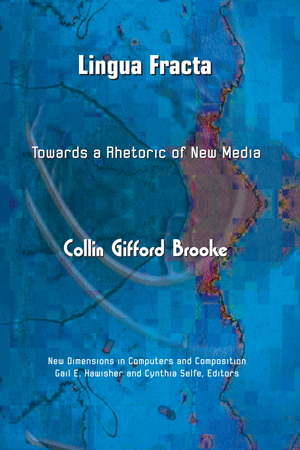Brooke, Collin Gifford. Lingua Fracta: Towards a Rhetoric of New Media.
Cresskill, NJ: Hampton P, 2009. 222 pp, ISBN 9781572738935
Reviewed by Kerri Hauman, Bowling Green State University
INTRO CHAPTERS 1-2 CHAPTERS 3-5 CHAPTERS 6-8 CONCLUSIONS

CHAPTERS 1-2 |
|
One of Brooke’s most pressing concerns is our tendency, as a field, to rely on habits inherited from literary studies. He raises this complaint because he believes we can’t simply take what we already know about writing and apply it as is to new media. For this reason, he spends Chapter 1, “Interface,” first identifying what a rhetoric of new media should not be. He critiques our continuing preference for textual objects and close reading (inherited, of course, from literature) as well as Bolter and Grusin’s concept of remediation, concluding that neither is sufficient and that we must, instead, shift our focus to interfaces. This argument leads directly into his focus in Chapter 2: ecology. In this chapter, Brooke draws on work from the transdisciplinary field of media ecology to explain why the canons provide a logical framework for a rhetoric of new media. Brooke argues that our understanding of the canons has become reified, which causes us to neglect them as the field continues to grow. He posits that we already assume, for example, that memory and delivery have fallen by the wayside due to the shift from oral to print literacy. Brooke believes, however, that the canons can continue to offer a broad and useful method of inquiry for new media, particularly if informed by insights from media ecology. In particular, using ecology rather than the writing process as a conceptual metaphor for the canons will grant us the flexibility we need in order to make the canons relevant for interfaces and new media. As a first step in proving this claim, Brooke recasts the trivium (grammar, rhetoric, and logic) as “layered ecologies,” which are more flexible and less stable than thinking of the trivium’s elements as we currently do – as separate disciplines. This new trivium consists of ecologies of code, practice, and culture. Brooke takes the canons, then, as an ecology of practice, embedded within his recast trivium, serving as just one scale at which we can examine new media. His intention is not to replace the terms of classical rhetoric but, instead, to add to them; he argues we should “see the inheritance of classical rhetoric as one possibility alongside others” (43).
|